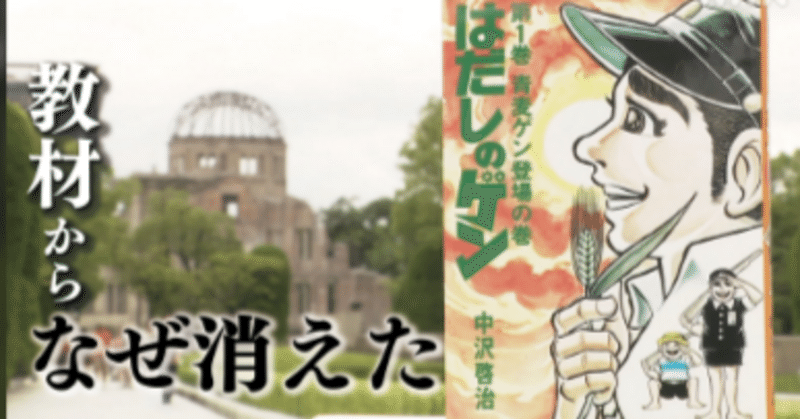
Barefoot Gen「天皇制批判?」「反日思想?」「自虐史観?」「はだしのゲン」は教材からなぜ消えた
戦後78年を迎えた2023年、広島市の平和教育副教材から漫画「はだしのゲン」が削除され波紋が広がっています。
原爆が投下された広島で、戦中戦後の苦難な時代を生き抜こうとする少年を描いた同作は、累計発行部数1,000万以上。
世界各国で読み継がれてきました。
そんな「はだしのゲン」が、なぜ削除されたのか?
情報公開請求で入手した膨大な改訂記録や、議論に関わった市教育委の担当者・教員たちの証言から、知られざる背景に迫りました。
以下、リンク先をご覧ください。
「はだしのゲン」なぜ削除? 背景に迫る - NHK クローズアップ現代 全記録
大論争にまで発展した「はだしのゲン」とは??
『はだしのゲン』は、中沢啓治による、日本の漫画作品。中沢自身の原爆による被爆体験を基にした自伝的な内容である。同漫画を原作として実写映画やアニメ映画・テレビドラマも製作された。戦中戦後の激動の時代を必死に生き抜こうとする主人公中岡ゲンの姿が描かれている。
当初は「週刊少年ジャンプ」で約1半年連載された。その後は1975年から連載再開した。連載先が変わっていき、革新市民団体雑誌の「市民」(1975~76年)、日本共産党中央委員会の「文化評論」(1977~80年)を経て、1982から87年まで日教組の機関誌「教育評論」に連載された。
自伝的な作品で、作中のエピソードの多くも中沢が実際に体験したことである。作者は当作を反戦漫画として描きたかったのではなく、それ以上に「踏まれても踏まれても逞しい芽を出す麦になれ」という「生きること」への肯定の意味を込めて「人間愛」を最大のテーマとして描いていた。
母親を火葬した際に骨が残らなかった、という作中にもあるエピソードが、中沢に広島原爆の被爆を題材とした漫画を描かせるきっかけとなった。
発表分の末期は終戦から何年も過ぎた戦後の内容となっており、昭和天皇に対する批判やアメリカ軍およびアメリカ合衆国に対する批判、警察予備隊(後の陸上自衛隊)発足に対する批判する内容も含んでいる。ただし、その時期の話にも原爆の傷痕は根強く描かれている。
時代考証の間違いや左派的な主張をはじめ、作品の内容、表現などについて様々な意見があるが、作者の中沢の実体験に基づく原爆の惨禍や当時の時代背景・世相風俗を表現していながら、エンターテインメントとしても読ませる作品として国内外での評価は高く、映画・ドラマ・アニメ・ミュージカル・絵本・講談化もされている。2010年6月調査のgooランキング「読んでおきたい日本史モノマンガランキング」の第1位に選ばれた。
2007年5月30日からウィーンで開催された核拡散防止条約(NPT)運用検討会議の第1回準備委員会で、日本政府代表団は、本作の英訳版を加盟国に配布することになった。外務省が英語版30冊を出版社から譲り受け、今後も「漫画外交」を活発に展開させる予定と報じられた。
2018年9月時点で累計発行部数は1000万部を突破している。
Barefoot Gen
Barefoot Gen (はだしのゲン, Hadashi no Gen) is a Japanese historical manga series by Keiji Nakazawa, loosely based on Nakazawa's own experiences as a Hiroshima survivor. The series begins in 1945 in and around Hiroshima, Japan, where the six-year-old boy Gen Nakaoka lives with his family. After Hiroshima is destroyed by atomic bombing, Gen and other survivors are left to deal with the aftermath. It ran in several magazines, including Weekly Shōnen Jump, from 1973 to 1987. It was subsequently adapted into three live action film adaptations directed by Tengo Yamada, which were released between 1976 and 1980. Madhouse released two anime films, one in 1983 and one in 1986. In August 2007, a live action television drama series adaptation aired in Japan on Fuji TV over two nights.
Cartoonist Keiji Nakazawa created the feature Ore wa Mita (translated into English as I Saw It), an eyewitness account of the atomic-bomb devastation in Japan, in the monthly manga Monthly Shōnen Jump in 1972. It was published in the United States through Educomics in 1982.Nakazawa went on to serialize the longer, autobiographical Hadashi No Gen (Barefoot Gen) beginning in the June 4, 1973 edition of Weekly Shōnen Jump manga magazine. It was cancelled after a year and a half, moving to three other less widely distributed magazines: Shimin (Citizen), Bunka Hyōron (Cultural Criticism), and Kyōiku Hyōron (Educational Criticism).[citation needed] It was published in book collections in Japan beginning in 1975.
Plot
Volume 1: A Cartoon Story of Hiroshima
The story begins in Hiroshima in April 1945, during the final months of World War II. Six-year-old Gen Nakaoka and his family live in poverty and struggle to make ends meet. Gen's father Daikichi urges them to "live like wheat", which always grows strong despite being trod on. Daikichi is critical of the war. When he shows up drunk to a mandatory combat drill and talks back to his instructor, the Nakaokas are branded as traitors and become subject to harassment and discrimination by their neighbors. To restore his family's honor, Gen's older brother Koji joins the Imperial Navy against Daikichi's wishes, where he is subjected to a brutal training regimen by his commanding officer, which causes one of Koji's friends to kill himself. On August 6, the atomic bomb is dropped on Hiroshima. Gen's father and siblings perish in the fires, but he and his mother escape. The shock causes her to give premature birth; Gen names his new sister Tomoko, so she will grow up to have lots of friends ('Tomo' means 'friend').
最後まで、お読み下さり、ありがとうございました。よかったらスキ、フォローよろしくお願いします😉
この記事が気に入ったらサポートをしてみませんか?
